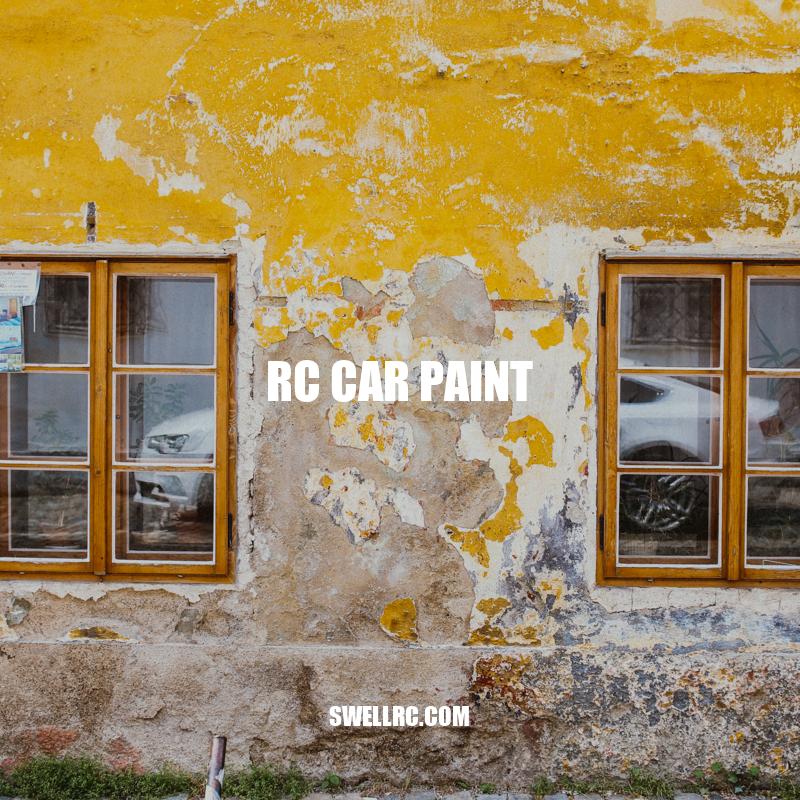RC Car Paint: Techniques, Tools, and Tips for a Professional Paint Job
RC Car Paint: Everything You Need to Know
Painting your RC car is an excellent way to customize your vehicle to match your style and make it stand out from the crowd. Whether you’re a seasoned painter or newbie, painting your RC car can be both a fun and rewarding process. However, to achieve the best results, it’s important to know the right paint type, techniques and tools to use. This guide will take you through everything you need to know about painting your RC car, starting from preparing your vehicle for painting, to picking the right paint type and techniques to apply. We’ll also be discussing the essential tools you’ll need and giving you tips on how to apply decals and add the finishing touches to your ride. By the end of this guide, you’ll have the knowledge and tools you need to create a professional-looking custom paint job on your RC car. So, let’s dive in and get started!
Preparing Your RC Car for Painting
Before you start painting your RC car, you need to prepare it for the painting process. Here are some things you need to do:
- Disassemble your car – To get the best painting results, you need to disassemble your car and paint each part separately.
- Clean and sand the parts – Use a mild soap to clean the parts and let them dry. Sand the parts with sandpaper to remove any rough surfaces. This will help the paint to adhere better.
- Mask the parts you don’t want to paint – Use masking tape to cover the parts you don’t want to paint.
- Prime the parts – Apply a primer to the parts you want to paint. This will help the paint to adhere better to the surface and make the colors stand out more.
- Choose the right paint type – RC car paint comes in two types: acrylic and polycarbonate. Acrylic paint is easier to apply, while polycarbonate paint is more durable and scratch-resistant.
By following these steps, you’ll ensure that your RC car is ready for painting and that the paint job lasts longer. Additionally, some websites offer helpful guides and videos on preparing your car for painting, such as RC Car Kings or Paintforcars.com.
Do you paint primer before painting?
Yes, it is recommended to paint a primer before painting on a new surface or a previously painted surface that has been sanded down. The primer helps to create an even surface for the paint to adhere to, and also helps to cover up any imperfections or stains on the surface.
There are different types of primers available for different surfaces, such as wood, metal, drywall, and concrete. It is important to choose the right primer for your specific surface, and to follow the manufacturer’s instructions for application and drying time.
Some recommended primer products include:
- Kilz Original Multi-Surface Stain Blocking Interior Oil-Based Primer/Sealer
- Zinsser Bulls Eye 1-2-3 Plus Interior/Exterior Multi-Purpose Water-Based Wall and Ceiling Primer
- Rust-Oleum Zinsser Cover Stain Oil-Based Primer Sealer
For more information and tips on priming and painting, websites such as Sherwin-Williams and Dunn-Edwards offer resources and tutorials for DIYers and professionals.
When it comes to painting your RC car, there are several techniques you can use to achieve different effects. Here are some of the most popular painting techniques:
- Airbrushing – This technique involves using a specialized airbrush tool to spray paint onto the car. This technique allows for more precise and even coverage, and you can create various effects such as fades or blends. Some popular airbrush brands include Iwata and Badger.
- Spray painting – Spray painting involves using a can of spray paint to cover the car, making it a faster but less precise method. You can achieve different finishes such as metallic, glossy, or matte.
- Hand painting – This technique involves using a brush to apply paint to your car and is perfect for adding small details like logos or designs. It is a time-consuming method but allows for more creativity and precision.
Each technique requires different tools and skills, so choose the one that fits your experience level and desired result. Moreover, you can find various tutorials and courses online that can help you improve your painting techniques. For example, websites like Udemy and Skillshare offer comprehensive painting courses taught by experienced artists.
Here is a table comparing the advantages and disadvantages of each painting technique:
| Technique | Advantages | Disadvantages |
|---|---|---|
| Airbrushing |
|
|
| Spray painting |
|
|
| Hand painting |
|
|
What kind of paint do you use on RC cars?
When it comes to painting RC cars, it is important to use paint that is specifically designed for plastic or lexan surfaces. The most commonly used paints for RC car bodies are polycarbonate spray paints, which are flexible, durable and water-resistant. Some popular brands of RC car paints include Tamiya, Pactra, Spaz Stix and Duratrax. Additionally, there are a variety of colors and finishes available including metallic, pearl, and fluorescent. Make sure to always follow proper safety precautions and use a well-ventilated area when painting.
Product(s):
– Polycarbonate spray paints – Tamiya, Pactra, Spaz Stix, Duratrax
- Flexible, durable and water-resistant
- Available in a variety of colors and finishes including metallic, pearl, and fluorescent
To paint your RC car, you’ll need to gather the necessary tools and materials. Here’s what you’ll need:
- Paint – there are several types of paint to choose from, including acrylic and polycarbonate. Popular RC car paint brands include Tamiya, Pactra, and Spaz Stix. Make sure to choose paint that is compatible with your type of RC car and chosen painting technique.
- Brushes or airbrush – A high-quality brush or airbrush can make a significant difference in the quality of your painted finish. Some popular brush brands include Windsor & Newton, Liquitex and Golden.
- Primer – Priming ensures that the paint adheres evenly to the surface and provides a smooth finish. Primer also helps the paint last longer and resist chipping. Popular primers include Tamiya and PlastiKote.
- Masking tape – this is used to protect areas you don’t want to paint, such as windows, headlights, and tires. Specialized masking tape for RC cars is available from brands like Frisket.
- Sandpaper – Sanding is necessary to create a smooth surface for the paint to adhere to. Sandpaper with grits ranging from 400 to 1000 is recommended.
- Paint booth or a well-ventilated area – This will help prevent the fumes from building up and ensure proper ventilation during the painting process.
- Air compressor – This is required if you’re using an airbrush for painting. You can choose from different types of compressors, including piston compressors, diaphragm compressors, and CO2 canisters.
- Cleaning tools – Keeping your airbrush and brushes clean is crucial to maintain their quality and longevity. You can use cleaning solutions like Createx Wicked Cleaner or Badger airbrush cleaner.
Having the right tools makes all the difference in achieving a professional-looking paint job. You can purchase these tools from specialized hobby stores or online retailers such as Amazon or TowerHobbies. Many online tutorials and forums can also help you decide which tools and materials to use.
How to paint tamiya RC?
To paint a Tamiya RC car, follow these steps:
- Clean the body with soap and water to remove dirt and oil.
- Apply a primer to help the paint adhere to the body.
- Sand the body to smooth out any imperfections.
- Choose your desired paint colors and apply in thin, even coats.
- Allow each coat to dry before applying another layer.
- Finish with a clear coat to protect the paint and add shine.
There are a variety of products available for painting RC cars, including Tamiya paints and primers. For more detailed instructions and tips, check out Tamiya’s website or hobbyist forums online.
Applying Decals and Finishing Touches
After painting your RC car, you’ll want to add some finishing touches to make it truly unique. Here are some tips on applying decals and adding other customizations:
- Decals – Applying decals can be time-consuming but is a great way to add a personalized touch to your RC car. Some popular decal brands include ABC Hobby, Newport graphics, and Bittydesign.
- Custom rims – Custom rims can transform the appearance of your RC car. Many online retailers offer options for different rim sizes, colors, and styles. Some popular brands include Proline, JConcepts, and RC4WD.
- Spoilers – Adding a spoiler can give your RC car a more aggressive and sporty look. You can choose from a wide variety of materials, including plastic, aluminum, and carbon fiber. Popular brands include HPI Racing, Team Losi, and PROTOform.
- Chrome – Adding chrome accents can give your RC car a polished and sleek appearance. Chrome sprays and foils are available from brands like Spaz Stix and Alclad II.
In addition to decals and customizations, it’s also essential to apply a clear coat to protect your paint job. Clear coats give your RC car a glossy finish and protect the paint from damage and fading. Some brands of clear coat include Dupli-Color, Krylon, and Testors. Various online retailers also offer complete car painting kits that include everything you need to start painting your RC car.
What is the first step before applying decals?
The first step before applying decals is to clean the surface thoroughly to remove any dust, dirt or grease. You can use rubbing alcohol or soap and water to clean the surface. It is important to make sure that the surface is completely dry before applying the decals. This will ensure that the decals will adhere properly and stay in place. For more information on how to apply decals, you can visit websites such as www.decalcity.com or www.signs.com.
Conclusion
In conclusion, painting your RC car is a fun and rewarding experience that allows you to showcase your personality and creativity. With the right prep work, tools, and techniques, anyone can paint their RC car. However, it’s important to take your time with the process and practice, especially if you’re a beginner. Don’t be afraid to experiment with different paint types, colors, and customizations to make your RC car truly unique. Lastly, always prioritize safety by wearing protective gear like gloves and goggles and working in a well-ventilated area.
Whether you’re a seasoned RC hobbyist or just getting started, painting your RC car is an excellent way to improve your car’s performance and aesthetics. By following the steps outlined in this article, you can achieve a professional-level paint job while having fun and being creative. So, what are you waiting for? Get your tools and start painting your RC car today!



